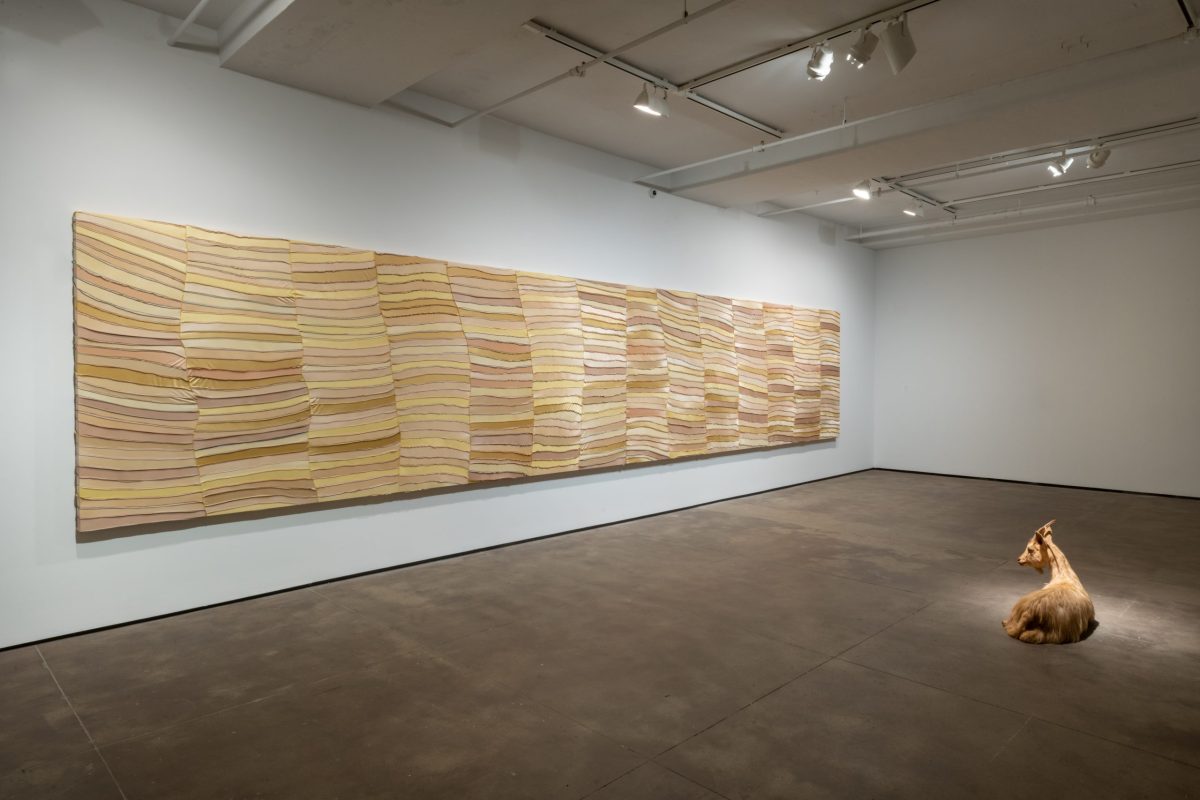[ad_1]
Along the front hall and bottom floor of New York’s Sean Kelly Gallery, a taxidermized goat contemplates a self-portrait, durags camouflage themselves as paintings and a diamond hides somewhere between it all. When separated, these elements may feel unrelated. Together, they reveal their relationship to each other—fetish, consumption and beauty: themes that populate Anthony Akinbola‘s latest exhibit, Natural Beauty. On view until 22 October, the Nigerian American artist’s solo show explores the connection and cultural connotations of objects through his diverse and unique display of readymade articles.

Akinbola’s signature durag paintings probe the accessory’s deeper values and associations, from race and respectability to mass production and commodification of culture. Scouring beauty supply stores throughout the city, Akinbola gathers classic and uncommon durags, organizes them by color and sews and staples them onto canvas. The resulting painting is loaded with nuance and a gratifying composition that, as the artist himself found, opens itself to endless revelation.

“When I started making this work, my goal was to kind of alienate my non-Black audience by presenting something like a durag, especially in an environment such as a high-end gallery,” he tells us. “What I learned is that the durag is, yes, specific to Blackness and Black culture, but it’s also American because Black people in Africa don’t wear durags. I’m Nigerian and I used to live in Nigeria and that would be seen in the same perspective of Western.”

As Akinbola’s durag paintings evolved, so too did his understanding of the object’s interpersonal and global dynamics. He continues, “When you look at the history of the durag, it comes down to straightening hair and this idea of assimilating into American culture. For me, there’s something interesting that it exposed: this thing is specific to Black people in this context, but it is an American garment. In my attempt to alienate my non-Black audience, I still find that people have this connection with the material. We can both be looking at this thing and it can be very visceral, but we’re seeing it in different ways.”

The paintings immediately feel intuitive, lush with rich hues and swaths of shiny fabric. The seamlessness belies how difficult it is to work with readymade, a form that comes with many constraints that are fittingly predicated on consumption. “I’m always really limited in the colors I have and that dictates what the painting is going to be, which is due to supply and demand of the durags,” Akinbola explains. “There’s also competition in the market which means I might go to a store and there’s five brands of durags and they all have red but they’re making a different tone of red. I actually enjoy the process of having a limited palette and having it be dictated by the market itself. It’s half a process of how to work with color and also half a process of how do I push the material and how do I work with the material.”

As much as the durag paintings are trademark artworks, the exhibit functions on the importance of relation—objects within dialogue of one another. Downstairs, a goat sits across from a large horizontal painting, with a color scheme that mirrors that of the animal. The artist refers to this work as the goat’s self-portrait.
“Goats are highly fetishized animals. It’s also the abbreviation that relates to sport and competition that goes into the fetishization of people and individuals themselves,” says the artist, noting how multivalent the animal is. This includes, for Akinbola, a mediation of identity between the US and Nigeria, where goats are prevalent and ritualized.

One floor above the goat, a diamond is discretely embedded into the wall which, the artist notes, “If we’re talking about contemporary fetish, it’s the perfect example. It’s one of the more highly fetishized things humans interact with.” He adds, “In talking about the mitigation of space between Africa and America or the West, the diamond is that thing and obviously super-political; there’s ethical discussions on diamond mining. I feel like that object ties Africa and the West together.”

All the objects act as sites of fetish, especially as they pertain to beauty. In situating them with each other, the exhibit questions how they’ve become naturalized and ingrained with varying perceptions. “With the whole exhibition, I just want people to get into what they see as being beautiful, how that relates to the objects in the show but also the objects they’d commonly interact with in their everyday life,” says the artist. Much like the goat observing itself, the exhibit prompts viewers to examine the objects within each work and reveal the labor, connections and connotations concealed inside.
Images by Adam Reich, courtesy of Sean Kelly
[ad_2]
Source link https://coolhunting.com/culture/anthony-akinbola-ponders-the-naturalization-of-fetish-at-sean-kelly-gallery/

Leave a Reply
You must be logged in to post a comment.